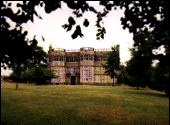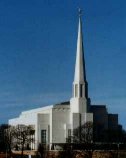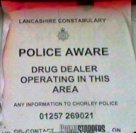The Refugees
Guide to Central Lancashire
 I
arrived in this country in 1980 seeking political asylum from Honduras.
I was held in a detainment camp and eventually sent to Chorley with a job
at the Vimto factory. When I first arrived, I found it difficult to understand
both the culture and the dialect. As a result I often found myself frightened.
For example, a guy would come up to me in the bar, push me aggressively
and ask me for a fight. I would say no. Typically such a person would then
offer to buy me a drink and say "Have a good night, mate." Paradoxically,
a girl would come over at the Applejax discotheque and offer a "quickie
behind Spar". I would politely say no and get punched many times in the
head! I was given no official advice about living and working in Central
Lancashire, only a useless Tourist Information guide. Most of the sights
it features are over thirty kilometers from Chorley, such as Blackpool
Tower and the Granada TV Studios. I decided to write the guide I needed
when I first arrived.
I
arrived in this country in 1980 seeking political asylum from Honduras.
I was held in a detainment camp and eventually sent to Chorley with a job
at the Vimto factory. When I first arrived, I found it difficult to understand
both the culture and the dialect. As a result I often found myself frightened.
For example, a guy would come up to me in the bar, push me aggressively
and ask me for a fight. I would say no. Typically such a person would then
offer to buy me a drink and say "Have a good night, mate." Paradoxically,
a girl would come over at the Applejax discotheque and offer a "quickie
behind Spar". I would politely say no and get punched many times in the
head! I was given no official advice about living and working in Central
Lancashire, only a useless Tourist Information guide. Most of the sights
it features are over thirty kilometers from Chorley, such as Blackpool
Tower and the Granada TV Studios. I decided to write the guide I needed
when I first arrived.
Astley Hall

According to the Tourist Information
guide, this is Chorley's main attraction. It's claims the house is a symbol
of past glory with which the people of the town closely identify. The truth
is that few local people have actually visited it. A residence was built
at the site in the 16th century, but Astley Hall has been rebuilt and extended
many times. It is misleading to claim, as the Tourist Board does, that
the building is actually this old. The building was once said to be pretty,
but unfortunately in the 19th century its brick exterior was replaced by
a dull cement.
All I can offer in defence of Astley
Hall is that it contains an impressive shuffleboard and admission is free.
The fact that the hall is sold as Chorley's premiere attraction suggests
the council are, to borrow an English expression, clutching at straws.
Inside the main entrance Oliver Cromwell's
boots are displayed in a glass cabinet. It would be nice to believe Oliver
Cromwell stayed here during the civil war and forgot his shoes, but it
is merely propaganda designed to increase the number of visitors. Predictably,
it is rumoured that Astley Hall is haunted and an underground tunnel connects
the building to a nearby church. They also tell such stories to the children
in my country.
The hall also hosts art exhibitions.
I use the term loosely. I only attended one such event and it will be my
last. It was advertised as an exhibition of the history of modern art.
It consisted of about ten printed posters, each of which I could have bought
for under three pounds from any university's Student Union. Near to the
Astley Hall is the ludicrous Stone Age Burial Site. It is a large
stone containing an engraved message, telling passers by that people once
lived here in the Bronze Age. Another example of the tourist board clutching
at straws.
The Mormon Temple

Mormonism was founded in 1830 by Joseph
Smith. Since he was 14, Smith had various supernatural experiences. One
was a vision of God and Jesus saying that the none of the worlds churches
were the true church. Another was an angel telling him where to
find a buried hieroglyphic book written on gold plates. He claimed to have
translated the 'magic' book, but would not tell of its location, and gave
his work a ridiculous title; The Book of Mormon. If the Mormons
are to be believed, the true church is not in Mecca, Jerusalem or Rome,
but in Chorley.
Most recent expansion of Mormonism
has occurred in the third world, particularly Mexico, where the recruitment
of new members is closely linked to a welfare programme. In Chorley, the
Mormon's recruitment strategy has involved sending out immaculately dressed
Americans riding expensive mountain bikes to tour housing estates. It is
difficult to see what this will achieve.
I have been told that a relatively
large number of Mormons live in Preston, hence the building is named the
Preston
Temple. Preston's council refused the Mormons' planning permission,
but Chorley's, presumably more corrupt, council allowed the temple to be
built on a green field site. The cost of the building is undoubtedly huge,
with over a million pounds spent on trees alone, though I would not believe
any of the estimates you hear in local bars. I have heard many such figures,
which tend to range between 20 and 250 million pounds.
As a gesture of goodwill, immediately
after the temple's completion, Chorley's population were allowed a free
guided tour of the complex, which I attended. Everyone was closely watched
by sharply dressed men in suits, who spoke occasionally into their communicators.
After a long period of queing, we were led into a room and shown a corny
promotional video of the worlds Mormon temples. In this room I noticed
a photograph of the temple's leader, who wore an outfit identical to that
of Airwolf's Archangel, but there was no eye patch nor mention of a stolen
helicopter hidden inside a volcano.
Before entering the temple itself,
we were made to wear plastic bags over our shoes, so not to contaminate
the sacred Mormon carpet. An official told me, after all the tours had
finished, the carpets would be replaced; further ensuring no Mormon would
walk on a desecrated floor. I was also ordered to leave my camera and umbrella
with security. The building was very congested with visitors and we slowly
shuffled our way around the predetermined and closely guarded route.
The majority of the temple was like
an opulent Travel Lodge, but one room stood out in particular; the celestial
room. I cannot remember the spiritual significance of the room, though
I would guess it is something to do with space. It reminded me of Las Vegas,
and the decorations looked as expensive as they were tasteless. There were
large chandeliers hanging from the ceiling, perhaps representing galaxies.
I also noticed small rooms filled with computers.
See the Mormon's Guide to avoiding
masturbation, For Young Men Only.
The Bus Station



|
Though now less impressive
than its heyday of 1982, the bus station is still the place that encapsulates
the feel of the town more than any other. It is best seen between 5 and
7 in the evening. When I first came to Chorley, I found it unbelievable
that many of the people who came here were not waiting for buses; the police
do not tolerate such idleness in Honduras. Young people came to drink bottles
of the award winning Slalom lager and listen to the futuristic sounds of
Electro on their, in eighties urban American slang, ghettoblasters. Another
popular venue for disaffected teenagers is Tripping Tunnel, which
runs beneath the M61 motorway and is home to the areas finest graffiti.
The long wall was once lined with vending
machines and photo booths; which were primarily used by teenagers sniffing
glue and discovering their sexuality and subsequently removed by the "nanny"
council. Throughout the eighties vending machines were continualy vandalised
and eventually removed in 1989. The last was a Coke-a-Cola drinks dispenser
which innexpilcably chenged position within the town center every few weeks;
though it met its demise on the bus station at the hands of the infamous
Alexander Eccles. Allegedly he kicked the drinks machine repeatedly until
dragged into a van by the police.
Older people tend to come in the mid-afternoon
and often reminice about times when bus travel was free to the elderly
and prescription drugs had more interesting side effects. Opposite the
bus station, on the Flat Iron, the Refreshment Bar cafeteria was
once extremely popular with listless pensioners. Though the food was poor,
the crockery dirty, the tea never quite right and the prices surprisingly
high, the atmosphere was second to none. Unfortunately, the council demolised
the Refreshment Bar to provide parking spaces for their ill-judged and
synthetic Market Walk project. |
In the words of the people
"Believe it or not most of my bus station
experiences have been unpleasant although it was the place that I bought
my first 200 or so comics and regular copies of Kerrang! Also sold Record
Collector, certain skateboarding mags (intermittently) and Bacon Flavour
Fries. I never liked the way that the cold wind whipped through the station.
You wouldn't have noticed since the bus you wanted was probably slightly
more frequent than the 357 daily bus to charnock Richard. I never had the
pleasure of being beaten up or arrested on th ebus station but I have seen
both happen to others with some frequency. I used to like it more before
it was painted brown when it used to have loads of weird stickers about
milk everywhere and a cast iron milk vending machine which looked like
something off a film set but actually worked sometimes."
(LH,Wythenshawe)

Frankly,
I haven't enjoyed
reading
this at all. Take me back. |

I never
knew a man from Honduras
could
be so fascinating. Tell me more, Dave. |



 I
arrived in this country in 1980 seeking political asylum from Honduras.
I was held in a detainment camp and eventually sent to Chorley with a job
at the Vimto factory. When I first arrived, I found it difficult to understand
both the culture and the dialect. As a result I often found myself frightened.
For example, a guy would come up to me in the bar, push me aggressively
and ask me for a fight. I would say no. Typically such a person would then
offer to buy me a drink and say "Have a good night, mate." Paradoxically,
a girl would come over at the Applejax discotheque and offer a "quickie
behind Spar". I would politely say no and get punched many times in the
head! I was given no official advice about living and working in Central
Lancashire, only a useless Tourist Information guide. Most of the sights
it features are over thirty kilometers from Chorley, such as Blackpool
Tower and the Granada TV Studios. I decided to write the guide I needed
when I first arrived.
I
arrived in this country in 1980 seeking political asylum from Honduras.
I was held in a detainment camp and eventually sent to Chorley with a job
at the Vimto factory. When I first arrived, I found it difficult to understand
both the culture and the dialect. As a result I often found myself frightened.
For example, a guy would come up to me in the bar, push me aggressively
and ask me for a fight. I would say no. Typically such a person would then
offer to buy me a drink and say "Have a good night, mate." Paradoxically,
a girl would come over at the Applejax discotheque and offer a "quickie
behind Spar". I would politely say no and get punched many times in the
head! I was given no official advice about living and working in Central
Lancashire, only a useless Tourist Information guide. Most of the sights
it features are over thirty kilometers from Chorley, such as Blackpool
Tower and the Granada TV Studios. I decided to write the guide I needed
when I first arrived.



